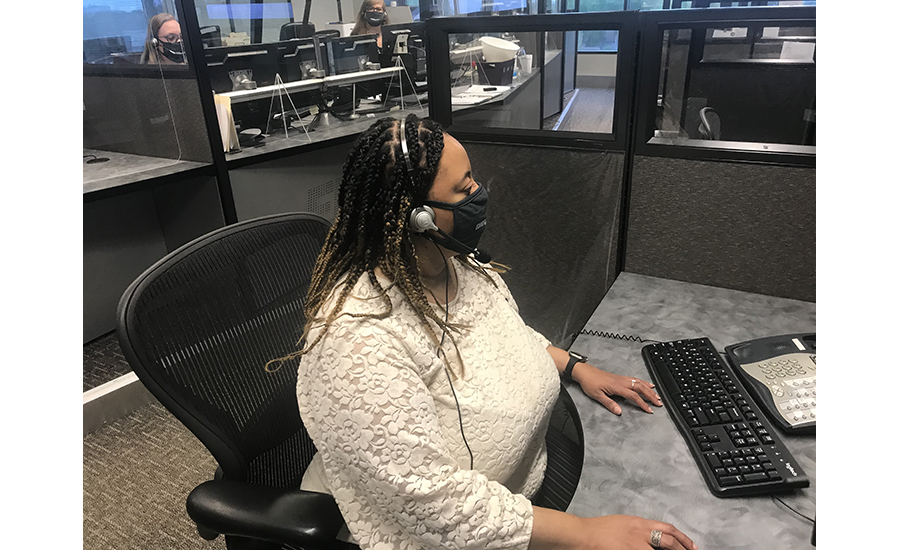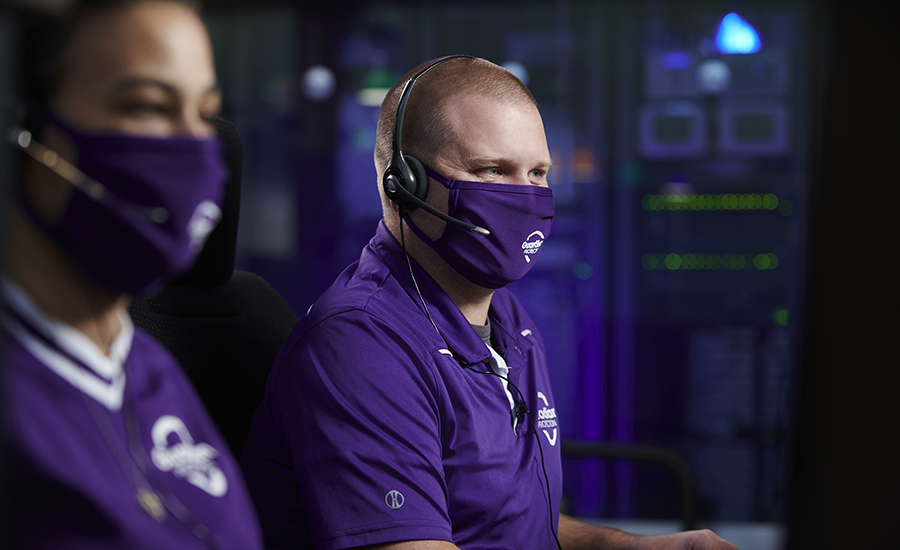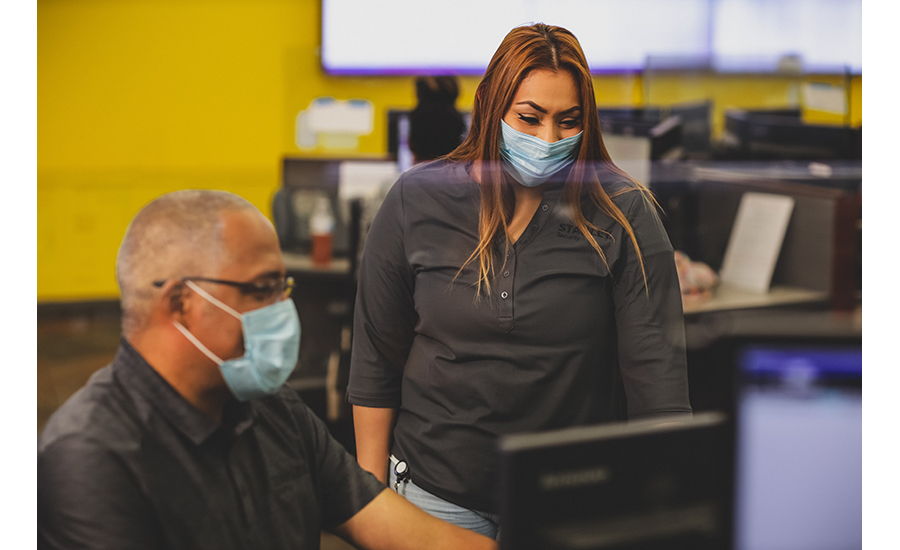No matter what business you’re in, your industry probably looks a lot different today than it did before COVID-19, and the security monitoring world is no exception. Back in January 2020, the industry was concerned about issues like keeping up with technology, false alarm management, hiring and retention, the 3G sunset, and cybersecurity. But while these problems didn’t go away — and some have become more urgent — they were shelved so companies deemed an essential service could focus on functioning during the pandemic. Expanded remote work, social distancing, enhanced cleaning, and leaning on analytics and automation helped monitoring centers stay operative during the worst of the pandemic.
Today, many companies still rely on these techniques to stay competitive in light of new challenges such as the “Great Resignation,” supply chain uncertainty, and the demand for new products and services for businesses running remotely and with reduced staff.
This has created both challenges and opportunities. The monitoring experts we spoke with — representing security dealers, industry associations, and third-party monitoring sources — paint a still-developing picture of how COVID-19 changed, and is still changing, the marketplace.
“While security should always be at the forefront of everyone’s mind, the definition of security expanded with COVID-19,” says Steve Walker, vice president of monitoring operations at STANLEY Security Solutions, a wholesale monitoring services company in Fishers, Ind. “Security has shifted away from simply protecting a business’s assets to also protecting the business’s people and their health.”
Many believe COVID-19 provided the opportunity to reevaluate conventional processes and introduce beneficial changes.
“When things are going well, no one takes a lot of time to worry about the future or assess the performance of their monitoring provider,” says Wayne E. “Trey” Alter III, president and CEO of Dynamark Monitoring, a third-party monitoring service provider in Hagerstown, Md. “I think COVID tested the industry and gave some of us an opportunity to show that we could perform in a tough environment. The monitoring centers we saw do well had a plan, revised it daily, and took proactive steps to mitigate risks.”

Amari Gordon, assistant manager at Emergency24 who has been with the company since 2000, masks up for a day of work at the height of the pandemic. // IMAGE COURTESY OF EMERGENCY24
Adapting to the Remote Revolution
The biggest workplace trend generated by COVID-19 was the evolution of work from home (WFH). Remote work has transformed everything at monitoring centers, from daily operation to recruitment, training, communication, and performance management — which has yielded increased productivity and reduced stress among employees, Walker says.
Monitoring centers typically operate at central locations with many employees all on site. When states began mandating business shutdowns during the pandemic, monitoring centers scrambled to set up remote workforces and institute CDC and OSHA sanitation and distancing requirements.
“Before (COVID-19), dispatchers were sometimes in one big room in four different time zones,” says Chuck Petrusha, president and CEO, Advanced Security Solutions, Eureka, Calif., and SDM’s 2021 Dealer of the Year. “Now how fast that came to fruition, the larger central stations jumped on the bandwagon almost immediately to isolate dispatchers.”
In March 2020, Underwriters Laboratories (UL) published interim operational guidelines for its monitoring station certification program customers, which suddenly faced local or regional public health mandates. That April, UL’s Standards Technical Panel created a working group, which included experts from the industry, to propose UL standards revisions that would permit monitoring alarm systems from outside a station during governmentally declared emergencies such as a pandemic. UL revised the standards in October 2020 to include the group’s proposed requirements for monitoring systems outside the station, including at an employee’s residence.
Then, in January 2021, The Monitoring Association (TMA) began work on a revision of UL 827, the Standard for Central Station Alarm Services, to include standards for monitoring remotely located operators, whether or not there is a governmentally declared emergency. The proposal was published as an official revision to UL 827 in September 2021. (see sidebar)
The move recognizes that the industry will continue some form of remote work even after COVID-19 abates, says Steve Schmit, senior staff engineer at UL’s Built Environment group. “Some form of work-from-home seems likely to remain in place permanently,” he says. “Organizations will have to rethink elements of culture building, onboarding, training and collaboration in a distributed team environment.”
Most monitoring centers have adopted a hybrid arrangement, with at least some employees working remotely.
For example, Guardian Protection, a Warrendale, Pa.-based security dealer and integrator, had previously used a “hot seat” system in which staffers shared work stations to maximize space. When COVID-19 hit, the company transitioned to a designated work space system, with stations wiped down for sanitation at the beginning and end of each shift, says Jason Bradley, Guardian’s vice president, care and monitoring operations. During the height of the pandemic, Guardian’s marketing, service dispatch, and tech support teams worked remotely, leaving only the monitoring staff and leadership on premises, providing more room to social distance.
Keeping specialists within the facility required monitoring centers to increase the focus on safety protocols. Rapid Response Monitoring, a third-party professional monitoring services provider in Syracuse, N.Y., had always maintained ultra-hygienic facilities, but doubled down on sanitation during COVID-19, says Morgan Hertel, vice president of technology and innovation. “We upgraded to Level IV UV HVAC filtration systems and added infrared temperature cameras, four-hour employee temperature checks, UV room sterilizers, UV sterilizing wands and boxes, social distancing of staff members, provided each employee with a touch-free thermometer for their home, and focused the 24/7 cleaning staff to sanitizing every workspace at the end of shifts,” he says.
“With all of the COVID shielding up, it looks a bit like a steakhouse salad bar,” quips Chris Newhook, director of monitoring operations at American Alarm and Communications, an Arlington, Mass.-based full-service monitoring company. Along with other precautions, the company installed a state-of-the-art air filtration system and stand-alone active air scrubbing units, and implemented a rotating remote-work schedule, with about 20 percent of the team working remotely each week. “Overall, the atmosphere in our central station is a bit more casual as there are fewer in-person interactions, and exposure to the public is still comparatively minimal,” Newhook says. “The relaxed dress code was met with no complaints.”
COVID-19 forced all sorts of professionals to use collaboration tools that improved their efficiency outside of an office environment — in some cases, more than when on-site, UL’s Schmit adds. For alarm operator agents, “having part of the workforce set up to work from home provides new levels of resiliency,” he says. “During a time of urgent need, staff can be up to speed very quickly when they don’t have to commute to the monitoring station.”
Some monitoring companies are less excited about the continuation of WFH.
“There are many instances when an operator needs guidance from a walking supervisor,” says Laura Stevens, chief executive at All American Monitoring, a third-party monitoring company based in Sarasota, Fla.
Immediate, ongoing quality control would also be an issue with operators working from home, arising from issue like internet stability, attention to incoming calls and signals, or the speed of their response, she says.
Gauging the Impact of UL 827 Revisions
In September 2021 remote work requirements were added to UL 827, The Standard for Central Station Services, which contains the “main body” of UL requirements applicable to U.S. monitoring centers. These requirements cover station facility construction, physical security, power supplies, communications infrastructure, IT/automation systems, cybersecurity, plus the details of service for commercial fire alarm, commercial burglar alarm, and residential monitoring, says UL’s Steve Schmit. UL 827 A applies to providers and monitoring station users of cloud-based “as a service” offerings from central station automation software providers and data centers, which could include work-from-home arrangements.
Many maintain that UL’s WFH options are a much-needed change that addresses the dramatic shifts in hiring and retention we see today.
“After 18-plus months of COVID-19 mitigation measures, career and workplace expectations have changed dramatically,” Schmit says. “Monitoring centers find themselves competing for talented operator agents in a labor market where work-from-home opportunities are common. We recently revised UL standards and our certification programs to accommodate work-from-home environments. We are hopeful that this will empower our customers to offer employment options that keep good people in the industry.”
The standards changes open up a whole new talent pool to an industry hunting for good people, says Chuck Petrusha of Advanced Security. “The latest standard of remote dispatchers changes the game,” he says. “It’s not about a large brick-and-mortar pack of people, but about WFH.”
Having a network of remote workers in place also spreads the risk in the event of a natural disaster — something Advanced Security, whose customers have been hit multiple times by California wildfires, is all too familiar with. “It goes back to disaster planning and what happens if an earthquake takes down our building,” Petrusha says. “If we’re all separated, there’s less of a chance of taking down our business. … It’s not new to the industry, but it came into the limelight with COVID and the isolation of employees and disaster planning is how you’d survive an incident.”
And while such behind-the-scenes changes shouldn’t really impact the end user, they will validate the quality of provider they are contracted with, Petrusha adds. “There’s a standard, just like the lamp in my office that’s built to a standard, that when a central station adheres to these standards, they will act in a certain way.”
The UL WFH standard redefines work station requirements for remote employees and will also create meaningful opportunities for innovation of tools used for employee safety, employee communications, and optimizing productivity, says Steve Walker of STANLEY Security. Because of this, upfront investment may be significant to help provide improved infrastructure, such as back-up power and redundant network connections, to avoid disruptions in service caused by localized power outages and internet services, he says.
However, not everyone is convinced that UL’s sanctioning of remote work should continue in the industry once COVID-19 dies down. Some companies maintained business-as-usual for monitoring center employees during the pandemic, relying on enhanced sanitation standards and social distancing but otherwise keeping operators on site.
“Rapid Response opted to maintain all monitoring operations within our facilities throughout the pandemic,” Morgan Hertel says. “This was an easy decision for us since we could safely run without any major changes due to the design of our facilities and because a remote monitoring model does not leverage all of the redundancy, data security, and personnel management we enjoy from within our standard centers.”
Others are concerned about the impact that remote work adaptations may have on end users. “The transition brings many issues to the forefront that essentially have weakened the security and provisions to monitoring services to the end user,” says Jason Bradley of Guardian Protection. “Standards are built to ensure the safety and protection of the customer and our employees. When those standards are changed to allow WFH, it undermines the years it has taken to develop those standards and the input that has been taken to design them.”
These range from the physical construction of the monitoring center itself, such as eliminating windows to ensure the privacy of information; regulations around redundant power sources; and highly controlled access to the monitoring center, which serves to protect the workers themselves from physical threats, Bradley says. “While those standards still remain at monitoring centers, many went out the window with work from home.”
Bradley is also concerned about the security of emergency contacts, passwords, and other confidential information that could potentially be breached by outsiders visiting a WFH site. “How secure is that information in somebody’s home?” he says. “There are no checks and balances in place. I would hope this was added as a temporary change, but at the end of the pandemic that it is quickly removed and normality is returned.”
UL is addressing the issue of monitoring center customer audits with some virtual techniques, Schmit says. “We learned that some elements of a UL audit were addressed virtually, while others were more difficult to audit remotely,” he says. “As COVID-19 mitigations allow more physical access to facilities, the UL audit experience will probably find a balance between a physical and virtual audit.”
However, standards of any kind are only useful if they’re adopted, says Chris Brown of Immix. While he believes the new UL standards will have some impact, “If it gets too hard, people won’t do it.”
Brown serves on The Monitoring Association committee that worked with UL to develop the new standards, which he thinks are a healthy response to COVID-19 realities. “But it will be interesting to see how truly adopted they really are and how much difference it makes in acquiring a customer. If I don’t have to have it to get a customer, I may not do it as a center. Whenever UL engages in getting standards together, it’s good because we’re not thinking about that as an industry. They’ve moved from enforcement to predicting, which is helpful. I think it will come out to be a good thing for the industry because it will get people thinking about what they can do better.”
Changes Driven by Technology
Efficient WFH is driven by technology, and companies that were tech advanced before COVID-19 transitioned more easily than others (see sidebar). Industry adoption of artificial intelligence and machine learning, which lagged pre-pandemic, took off to accommodate a remote workforce and meet changing customer demands.
“For the last 40 years, monitoring has predominantly been a service-based business, and while it still is, technology is playing an increasingly bigger role,” says Dynamark’s Alter. “We are in the midst of a technological arms race that is creating a wider gap between companies that just cannot invest enough to reach scale and those who are already there.”
In 2021, Dynamark introduced two major technology additions. InSite is a free cloud software platform that enables dealers to manage their business remotely, and Instant Connect is an app that can notify customers of false alarms, chat with contacts, and cancel the alarm straight from their phones.
“Many centers found ways to quickly accommodate staff while maintaining their business,” says Chris Brown, CEO of Immix, a Tampa, Fla.-based software provider. “Our product is … web-based and portable, so our employees could just take it home on a laptop. But many were not set up to do that, using software they built themselves or others just didn’t allow for it.”
He recalls the case of one Immix customer that responded to social distancing requirements by leasing the building next door and running cables across a parking lot to accommodate the required separation of employees. “In the beginning, if one person in the office got COVID, they were shut down,” he recalls. “It was a very scary time. But what came out of it was that people learned how to deliver services from remote agents, and now the trend is some are back in the center and some aren’t. I don’t think that would ever have happened if not for COVID. … All of that will carry forward for us forever and will help the industry thrive and grow because it’s become more flexible.”
AI had already been on the agenda at Immix as a way to help reduce false alarms related to video monitoring, Brown says. But while the tool had already been useful for detecting people and vehicles and “whether somebody is going in through the out door,” Brown says, it was suddenly a key component for building efficiencies in monitoring centers after COVID-19 struck.
“Lots of training is involved with being a video operator, so when centers were losing staff because of the pandemic, it became a problem,” Brown says. “Centers using AI (to detect false alarms) lifted out 80 percent of their false alarm traffic, so they didn’t need the head count they had before. It was almost a saving grace for them. Adoption was radical in an effort to save a business.”
Machine learning, analytics, and an ever-increasing reliance on algorithms are also driving change, Newhook says. “The industry is moving rapidly toward the ability to pull together massive data sets and make intelligent, accurate, and fast decisions that better support our response,” he says. “Automation, simply put, lightens the load for our teams, affording us more time with the customer, with customers embracing ‘tech’ like never before. You don’t have to convince them of the need for it; they now demand it.”
Not all technology changes were made in response to COVID-19. COPS Monitoring, a wholesale professional monitoring service in Williamstown, N.J., updated its tech infrastructure to stay ahead of the demand for services like mPERS and dispatcher-verified video, says Jim McMullen, president. The company spends as much as $180,000 per month on these advances, which include an upgrade to its suite of cybersecurity hardware and software; increased email security; additional receivers and receiving capacity; an upgraded, dedicated mPERS monitoring room in New Jersey; and a second generator to its Texas location.
But while new tech tools are essential to the industry, there is a cost — literally and figuratively.
“Staying ahead of the technology curve and the demand for services, along with continually reinforcing cybersecurity measures, is expensive,” McMullen says. “While these may impact both dealer-owned and third-party monitoring centers equally, we believe that small to mid-sized monitoring centers may struggle to make the necessary capital expenditures.”
And technology can be a double-edged sword: too much customer reliance on DIY technology could compromise the relationship between security provider and client.
“From a monitoring center standpoint, networks improve, equipment and services improve, things get faster and smarter all the time, and Guardian is forward-thinking about embracing technology for the end user," says Bradley of Guardian Protection. "But nothing replaces the actual interaction between a well-trained monitoring center operator and the consumer. We want to keep that human-to-human interaction pristine and well-supported by technologies that we believe are well-tested and that we trust.”

Since its employees were required to follow other CDC and OSHA guidelines, Guardian Protection provided them with company-branded masks. Pictured on the job are Monitoring Center Protection Specialists Michelle Green and Larry Kittelson. // IMAGE COURTESY OF GUARDIAN PROTECTION
Grappling With the Great Resignation
Another top-of-mind concern is one that has gotten plenty of media attention: finding and retaining talent
“We are used to being required to quickly pivot when necessary; however, no one was prepared for the supply chain issues — not just for hardware, but also people,” says Hertel of Rapid Response. “The labor shortage has affected every business and organization in the country. Not only is it hard to hire in general, but also the cost of labor has risen 30 to 40 percent in an industry that hasn’t been able to increase its fees in many years. This is going to change the fundamental business models going forward.”
While the “Great Resignation” may not be as apparent in monitoring as for other businesses, sources agree it’s definitely challenging. “Hiring is very difficult now,” All American Monitoring’s Stevens says. “Getting people to show up for an interview, or even to come to work if they do make it through the hiring process, is a challenge that many businesses experience — including ourselves.”
Many security businesses are increasing pay and benefits to entice workers. Emergency24, a family-owned national central station company headquartered in Des Plaines, Ill., has increased pay, offers referral and retention bonuses, and provides new employees a WFH option after six months on the job if they meet performance and quality metrics, says Kevin Lehan, national sales and marketing manager.
“Staffing has become a challenge, no question about it,” Bradley says. While the company is doing well with retention, and is known for the longevity of its monitoring team, it has had to try different recruitment methods, from partnering with outside employment agencies and organizing job fairs at its corporate headquarters. “Guardian has an excellent reputation, and we need to share that and market those benefits and our culture so they do look at selecting us as a possible place of employment,” he says. “There are good people out there, it just takes a lot more searching to find them.”
Finding good employees is one thing; training them is another, a task made more challenging by remote work. In response to a defection of technicians several years ago, Advanced Security shifted its hiring philosophy from seeking technically proficient people to those who were “people serving,” Petrusha says.
“We realized we had to get people outside of the industry and train them, not expecting them to come fully trained. That helped us get ahead of the curve a bit.” With help from the California Alarm Association, Advanced provides in-house FSP-1 field service training for new hires, which has helped the company become almost fully staffed.
COVID-19 Drives Big Tech Adoption
Many tech trends that exploded in the security monitoring industry during the pandemic were already on the horizon well before COVID-19 struck, but achieved new immediacy due to the pandemic.
One standout is the increased interest in video and event-based monitoring, which saw a huge uptick during the pandemic says Chris Brown of Immix. In pre-COVID-19 days, many customers still wanted a guard on site and weren’t really considering video monitoring. “But suddenly the people at the car dealership went home and … now they had outdoor exposed inventory.” Add to that the social unrest that exploded in the summer of 2020, and remote video monitoring became a must-have.
“Sales went through the roof for most of our established customers,” Brown says. “We saw a huge uptick in new sales and opportunities. We also developed new services and started to do things that weren’t just security because staff couldn’t be there.”
National and global enterprises that didn’t consider video monitoring before COVID-19 — auto manufacturers, large retailers, insurance companies, large national legal and accounting firms — jumped on the bandwagon because of the lack of security guards. “We saw service expanded in a million different ways that will now never go away,” Brown says.
Leaning into the end of COVID-19, there are limited policing resources, which also affects the demand for more technology for security. “This industry is very simple: Professional monitoring as a whole depends on one single thing to be relevant,” Brown says. “We can send somebody; otherwise, what’s the point? We have a fiduciary responsibility to do everything we can to protect law enforcement.”
To that end, Immix has partnered with Incident Code on a system that delivers video and other actionable information directly into the hands of responding officers. Monitoring center operators examining video from multiple cameras can snapshot videos and deliver them to anyone with web access via a hyperlink — including police, customers, 911, the responding party, or a building manager. As an event unfolds, the monitoring center can take photos or video and deliver to police and other recipients in real time of everyone has the same real-time information.
Other tech advances that grew during COVID-19 include data and analytics. In 2021, STANLEY Security added analytics-based video verification, water leak detection, customer alarm response through group chat, gunshot detection, and enhanced customer-facing applications, says Steve Walker. “Using analytics as a driving force and leveraging more automation in monitoring centers allows for insights to be managed more effectively,” he adds.
False alarm claims continue to be a thorn in the side of monitoring, and one that is increasingly mitigated through technology. “The increase of punitive false alarm fines toward end users, dealers, and the central stations and time consuming ‘cry wolf’ programs have a severe impact,” says Laura Stevens of All American Monitoring. “It is surreal how much time and resources we have to dedicate just to permitting, registrations, licensing at so many levels, including state, county, and city.”
Advances in PSAP services and technology are helping to reduce false alarms, says Kevin Lehan of Emergency24. “We continue to grow and receive great fire department feedback on our revolutionary PSAP services program,” he says. “This exclusive solution expedites dispatch digitally, lessens the workload at municipal level dispatch centers, and provides valuable benefits in terms of efficiency, risk mitigation, accuracy, and control for fire departments.”
“[As a third-party central station] we have to support everything, so we can handle any type of signal, including Alarm.com and Alarmnet,” Lehan says. Emergency24 also supports the CHeKT video platform, and has established a strategic partnership with BluePoint Alert Services for active shooter solutions as an RMR-generating service.
Finally, all of these add-on services, if they’re not already there, will migrate to the cloud, which will become standard in the future, says Chuck Petrusha of Advanced Security. “We no longer have to rely on a box in the closet,” he says. “That’s coming sooner than later.”
The cloud will enable increased industry use of artificial intelligence linked to the Internet of Things, Petrusha says. “We live in a world of sensors, and our industry will be installing that. Those sensors are what we do. In the future, I can see more AI-driven, cloud-based services providing a level of security and convenience to consumers unmatched to what we have today.”
Supply Chain Uncertainty
While the monitoring world struggles to find workers, a global supply chain crisis is causing shortages of goods and materials, causing severe delays in receiving equipment and slowing down the process of upgrading systems.
Shortages are especially acute for computer chips used in audio equipment, which is slowing down installations for the increasing number of customers who are adopting video, says Brown of Immix. “Video monitoring uses a lot of audio, especially one-way voice systems to push perpetrators off a property,” he says. “Those speakers are very challenging to get now, and many companies can’t finish installations because of audio equipment shortages. It’s hindering delivery of services because of it.”
Shortages are also preventing growing monitoring centers from increasing their server space, he says. “Centers need to buy more server hardware space, whether in the cloud or not, and it’s hard to get servers today. Limited computer technology and chips are becoming a tug-of-war between supply and demand. Smaller companies are challenged to get products because larger companies can buy them at a higher price, whereas the small guys can’t.”
Anticipating that the chip shortage will continue through second-quarter 2022, Advanced Security is ordering parts months in advance and carrying inventories in order to finish larger-scale projects like control panel installations.

Operators at STANLEY Security’s Minneapolis monitoring center wear masks during the height of the COVID-19 pandemic. // IMAGE COURTESY OF STANLEY SECURITY
Looking Into the Future
Although COVID-19 may have begun loosening its global grip, it isn’t going away; and workplace and other changes that monitoring centers introduced during the pandemic are not likely disappear.
“Many of these changes have opened the door to a quality of life enhancement that may not close again,” American Alarm’s Newhook says . “We are really just coming out of it and still see the attendant anxiety and fallout of the last 18 months. I’m not as sure the pandemic is over as much as it has moved into another phase. It has been an incredibly turbulent period and it’s understandable folks remain somewhat tentative about jumping back into the pool too soon.”
The tech boom will require the industry to be more vigilant about its own security, Dynamark’s Alter says. “Monitoring centers should be focusing more on their cybersecurity than they have in the past,” he says. “There are more people working remotely and more customers connecting to web servers than ever before and that brings with it increased risk. We have focused our energy and dollars into hardening our defenses and having a Plan B and Plan C. Virtual and Hyper-V environments now allow us to run redundant applications and spin up new ones very quickly.”
As far as the workplace, most agree that WFH in some form appears here to stay. “I do think we will see remote and hybrid work remain,” Alter adds. “Whether that is one day a week or five really depends on the company and the position. Not all jobs translate well in a work-from-home environment, and not everyone wants to work from home. In this business, nothing is permanent. COVID taught me to plan for the future but stay flexible because things can change in an instant.”
But in spite of the ebb and flow of COVID-19 cases, variants, and restrictions, “COVID is here to stay,” Hertel says. “All businesses and organizations will be dealing with it for a long time to come. As a society, we will get better at pivoting and medical science will get better at dealing with it. However, I believe we are going to be compensating in many different ways for the foreseeable future.”






